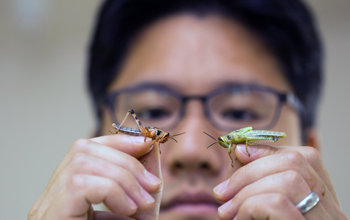Multimedia Gallery
Studying phenotypic plasticity in locusts (Image 1)
Hojun Song, an assistant professor of biology at the University of Central Florida, holds two non-swarming grasshoppers that are from the same egg pod but were reared in a crowded condition (left) and in an isolated condition (right). Research by Song has found that some non-swarming grasshoppers that are related to the desert locust respond differentially to rearing density.
More About This Image
All locusts are grasshoppers, but not all grasshoppers are locusts. Locusts are a special type of grasshopper capable of altering their shape, color and behavior in response to a change in density, an ability known as locust phase polyphenism. At low density, the phase is called "solitarious." At high density, the phase is known as "gregarious." This ability is not fixed; the trait is reversible within the life of a grasshopper. "You actually can induce them to change from one form to another in the lab," Song says.
Desert locusts belong to the genus Schistocerca. Song is studying the entire genus, which contains about 50 other species. He is trying to determine whether the others have a similar ability to undergo these changes, and, if so, to find the molecular mechanism behind it. "Our overall goal is to understand why some grasshoppers become locusts," he says.
"We know desert locusts can change, but it's not clear about the other species," he adds. "Within the genus, there are three other species known to be locusts, but the rest are just regular grasshoppers, not known to swarm. The question is: Do they have the ability, but live in an environment not conducive to swarming? Or do they not have the ability at all?"
The question is important because swarming locusts are among the most serious pests in the world and can be very destructive to agriculture. Controlling them with pesticides is bad for the environment. Results from Song's research could lead to a new method of controlling locusts through the manipulation of their genes as they develop.
Song is conducting his research under a National Science Foundation Faculty Early Career Development (CAREER) award (grant IOS 12-53493).
To read more about Song's research, see the NSF Discovery story Controlling destructive locusts by manipulating their genetics. Or visit Song's lab website Here. (Date of Image: June 2013) [See related image Here.]
Credit: Derek A. Woller, Department of Biology, University of Central Florida
See other images like this on your iPhone or iPad download NSF Science Zone on the Apple App Store.
Images and other media in the National Science Foundation Multimedia Gallery are available for use in print and electronic material by NSF employees, members of the media, university staff, teachers and the general public. All media in the gallery are intended for personal, educational and nonprofit/non-commercial use only.
Images credited to the National Science Foundation, a federal agency, are in the public domain. The images were created by employees of the United States Government as part of their official duties or prepared by contractors as "works for hire" for NSF. You may freely use NSF-credited images and, at your discretion, credit NSF with a "Courtesy: National Science Foundation" notation.
Additional information about general usage can be found in Conditions.
Also Available:
Download the high-resolution JPG version of the image. (2.3 MB)
Use your mouse to right-click (Mac users may need to Ctrl-click) the link above and choose the option that will save the file or target to your computer.



